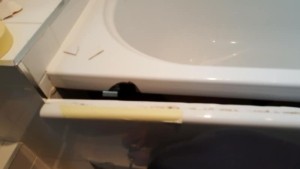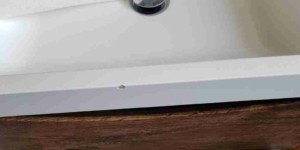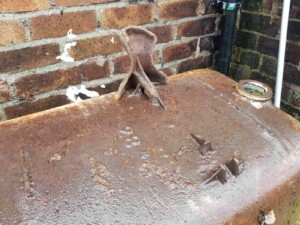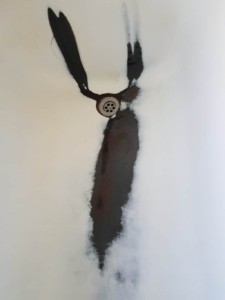Most common bathroom suite damage.
For every repair around your bathroom suite damage, there’s usually same set of questions I have to go thru to prepare for the visit and estimate. Before I can proceed with solution, I always try to reach the answer to what type of damage is it, what surface is your sanitary piece made of (material and colour), and was it already repaired in the past? If there’s a rust around the waste, it’s obvious that this would not be a modern plastic bathtub type. It’s easy to find by yourself what is your sink or other bathroom equipment made of and what type of repair you’ll most likely need if you follow that simple guide thru a typical damage description below.
It’s worth to mention that if you have a small area damaged but otherwise the surface is in good condition, there is no need for a full resurface/ enameling.
Common damage to modern acrylic bath edge happens when pulling the panel out.
Repairs to bath, shower and other acrylic-made surfaces:
A small ‘ding’ to an acrylic basin – a small area repair. No need to resurface or replace the whole basin! 2hrs repair, the picture after – below.
If there’s a problem with any acrylic surface there’s usually just a few typical damage types:
- It is cracked (sometimes a hole thru) or scratched in one or a few places. Damage caused by dropping an object or scratching with something sharp.
My solution: I fill and level, than reinforce if needed and spray the colour matched topcoat to the damaged place. What I do different than the DIY and many companies is I have structural resins that reacts with acrylic and became an integral part of the surface, will not separate after a while (lift) as some competitors products. I also stop the crack from spreading further. However the most challenging is colour match. To spray a part of a surface and make it hard to find after, the fine colour adjust is needed. Colour match can be difficult but most often decides about the quality of repair.
- It is scratched but the scratches are not deep.
Solution: For a shallow scratch marks it is often possible to polish it out as long as there is enough material in the topcoat to do that, it’s completely undetectable method of fixing the damage and doesn’t require to apply any topcoat. Method is to diminish the damage with removing a few microns of the topcoat with fine sanding and polishing after to equal the gloss level.
- It is stained, surface reacted with chemicals (cleaners) or it’s got cracks along the entire surface.
Method of fixing: If chemical cleaning and polishing would not bring the desired result, resurface is the only option.
Not every acrylic or fiberglass piece can be saved. Sometimes there’s no value, sometimes it can be end of its life as fibreglass bathtubs and other resin types not only gets damaged easier than iron or steel types but also have a shorter lifespan.
Cast Iron and pressed steel made units:
The main difference between metal made sanitary equipment and any plastic type (incl. fiberglass, gel coat, resin, etc.) is that second are not enamel coated. That is one of the reasons why I use the word ‘resurface’ more often than ‘enameling service’ (or re-enameling and any other variation you can encounter).
The way the metal made bathtub will look after you test it with something heavy will most likely produce a different result than a hammer dropped onto a porcelain toilet or acrylic shower tray. I’m not encouraging you to test my words, I’d rather show some pictures and description below of what you can expect with different treatment.
A steel tub is only a few millimeters thick, rust penetrated from under showing the corrosion on the shoulder. Can be repaired.
One of (not so) many benefits to acrylic tubs is that you won’t see anything like this on any of it (both items has been successfully restored by me).
1. Chipped enamel – as with acrylic it can be a small ding, but most likely it won’t be a damage thru the metal surface. Pressed steel bath can bend (I’ve seen thin material made bathtubs that got deformation to the inside from feet support place.) when something fall onto it but hardly ever you will see a damage thru. Cast iron is bulletproof and won’t bend. Because the metal made ware is rigid, the enamel under stress will show a different tendency than acrylic surface. It rather chip off as a small ding, exposing the metal (or black factory primer) shell. Solution – as above with acrylic chip repairs.
2. Enamel is rough, dull and pitted – old enamel and surfaces treated with heavy chemicals (bleach can be enough) discolored with hair dye or other, opposite to acrylic can’t be fixed by polishing. The enamel surface is rough and not immune to polishing, it’s even hard to abrade with sandpaper. Any cleaning and polish service is a very short-term effect solution. It has to be resurfaced partially and in most cases, it’s a full resurfacing project.
3. Rust – mortal enemy of most resurfacers ;) It can be a pain(t) in a bum, as most often what it appears on the visible place is a tip of an iceberg. For instance, rust around the plughole area can be treated to where I can reach, but may re-appear again within time. Thanks to more experienced technician expert who was keen to share his years of experience with me (a big thank you to all who helped me to became a quality resurfacer!), I use a 5-step system to deal with it, and have good results since.








Leave a Reply
Want to join the discussion?Feel free to contribute!